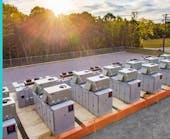AI is top of mind in Energy Management: Insights on a Predictive Grid from Veritone GM Sean McEvoy
The artificial intelligence portion of the fast-growing energy management technology sector is relatively small, maybe 10 percent of overall financial activity within the grouping, according to some reports.
Here’s some predictive maintenance on that: AI is one of the top As if you are keeping grades on the energy transition future. It is shaping up as a tool to help alert, allocate, activate and anticipate the movements of an increasingly varied distributed energy resource grid.
“Not only is it getting smarter with every command, every week AI gets better,” noted Sean McEvoy, general manager and head of energy at Veritone. “That’s what starts to blow them away.”
The “them” are industrials and energy companies accelerating their AI adoption and stakes in energy management systems which can coordinate the intermittencies of solar and wind with battery storage and other resources. The efforts can smooth out rough patches, maintain frequency on the lines and determine the best times for dispatching generation in the markets.
Veritone itself is growing its role at the intersection of renewable adoption and battery storage. The software-digital controls firm has recently announced partnerships with Empower Energy and Positive Energy.
The latter deal with Positive Energy will deploy Veritone’s iDERMS (intelligent distributed energy resource management) platform to predict the useful life of recycled battery assets. Last month, Veritone announced a deal with Empower Energy to help determine the right-sizing of battery energy storage systems in combination with renewable projects in the Electric Reliability Council of Texas (ERCOT) market.
Veritone also is partnering with Competitive Power Ventures to provide services in accessing the PJM Interconnection market. The common thread with all of these projects is providing AI-assisted predictive analytics that reach from grid balancing to frequency response and peak shaving and predictive analysis.
“You have to make it work in time and make them (the customers) aware of what’s going on,” McEvoy said. “If you can solve the interconnection problem, we can do the rest.”
And the AI/energy management sector is expanding fast, perhaps five-fold or more over this decade, according to various forecasts. It certainly has gotten the attention of M&A-minded big players such as Mitsubishi Electric, Generac and Schneider Electric, which have recently acquired management technology-focused firms like Smarter Grid Solutions, Enbala and AutoGrid, respectively.
For they all know that if this massive renewable energy adoption is going to even work, it will need big-time digitalization guidance and real-time decision making. The grid challenges in Texas, which has nation-leading wind power penetration, provide instant use cases for the value of AI and digitalization.
“Sometimes there’s not enough wind, sometimes too much and you have to curtail,” McEvoy noted. “That’s where batteries come in. . . (AI combining grid output and weather data) can forecast renewable power output for the next week or month.”
A truly next-gen economic model may be Veritone’s collaboration with Positive Energy on recycling electric vehicle batteries and repurposing them in microgrids and other distributed resource functions.
Although EVs have not attained mass adoption yet, there are millions of vehicles in operation which have a generation of batteries reaching end of life in e-Mobility. Positive Energy’s business plan is to take those batteries, combine them in packs or modules and sell to customers for various purposes.
The commercial and industrial sector is becoming a big customer for these combinations. Independent power producers and utilities also are deploying energy storage frequency response, grid smoothing and other functions such as peak shaving. Positive Energy offers these stacked-together recycle battery combinations and offers the resource as Energy as a Service (EaaS) with no upfront costs to the buyer.
“The new owner needs to know with the charge and discharge about what the useful life is” of the batteries, McEvoy said. “The customer says ‘I want a megawatt of storage from you consistently, so it’s up to Positive Energy” to make sure the battery is operational and dependable or whether it needs to swap it out for another.
Veritone operates the system and looks at sensor data to make instant, crucial decisions.
“We create a digital twin model of each of these batteries, apply an algorithm to determine remaining use life,” he added. “We get down to the physics and chemistry at the cell level.”
Chemistry is important in all battery applications but intensifies at the utility-scale or microgrid levels. Some utilize lithium ion, which has a shorter duration, or vanadium redox flow systems for more than four hours discharge capacity.
“If they are dispatching once a day for peak having, they may configure the battery for 4 p.m. to 8 p.m. discharge,” McEvoy pointed out. “Something that you dispatch once a day, at the same time, that battery will last longer than a customer doing fast frequency response...that one would degrade a lot faster.”
The Federal Energy Regulatory Commission’s Order 2222 allows distributed generation resources to bid into various markets. FERC 2222 has opened potential for battery storage participation in the PJM Interconnection, the California Independent System Operator and Energy Imbalance Market.
Veritone and other competitors also offer financial analysis as part of the package, determining best times to bid into the competitive electricity markets. And some regulatory agencies finally are catching up, approving entries for battery storage interconnection into the macro grid.
“It opens a whole new avenue for us,” McEvoy said.
-- -- --
(Rod Walton, senior editor for EnergyTech, is a 14-year veteran of covering the energy industry both as a newspaper and trade journalist. He can be reached at [email protected]).






